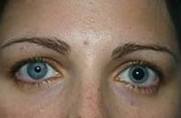|
About Anisocoria
Anisocoria is result of unequal size of the pupils. It may perturb a person and may lead to low self esteem. Anisocoria may be a result of injury to the head or eyes and spinal cord or toxic shock. It may have to be treated as a medical emergency.
Pupils are similar to camera lenses. They increase in size to allow more light to enter the eye when it is dark while they decrease in size when it is too bright. Normal pupils dilate or increase in size in the dark and decrease or constrict in the light but the abnormal pupil becomes much larger in dim conditions or smaller in light conditions than normal. This creates the impression that the pupil sizes are unequal. Anisocoria is severe in dim or dark conditions.
 In most cases, Anisocoria is harmless and observed in a significant number of people. In fact almost 20% of people seem to have some degree of Anisocoria. Anisocoria may be temporary or permanent in nature. Anisocoria may affect everyone from little babies to adults and is found in both sexes. Anisocoria is also found in animals. In most cases, Anisocoria is harmless and observed in a significant number of people. In fact almost 20% of people seem to have some degree of Anisocoria. Anisocoria may be temporary or permanent in nature. Anisocoria may affect everyone from little babies to adults and is found in both sexes. Anisocoria is also found in animals.
Causes of Anisocoria: The exact causes of Anisocoria are unknown but several risk factors have being identified.
Benign or local ocular pathology: The inherent tissue and cellular structure as well as the injuries, inflammation, deformities, infections etc. to the ocular area can lead to Anisocoria. These conditions may be caused due a wide variety of factors like toxic exposure, injury, birth defects, drug side effects, etc.
Medications: Both systemic and topical medications may leave behind side effects. For example:
- Miosis induced via cholinergic agents which cause constriction of the smooth muscle fibers of the iris.
- Mydriasis induced via Sympathomimetics and anticholinergics which causes relaxation of these nerve fibers.
- Topical anticholinergic medications may not work on certain patients unresponsive to pilocarpine causing abnormal pupil sizes.
- Local trauma and inflammation: Includes iris lacerations, iritis, glaucoma, lens dislocation and previous eye surgery.
Adies tonic pupil: It is usually found in younger women. It may be induced due to diseases such as syphilis. In this case, pupils may be nonreactive to light changes but reactive to convergence signals.
Argyll-Robertson pupil: It is mostly caused by tertiary syphilis. Patients have small or irregular pupils. They have to face visual acuity.
Horner's syndrome: It is a rare disorder. Its causes and effects are as follows:
- Lesions of the sympathetic chain, Spinal cord lesion, cervical rib, lymphoma, Pancoast tumor, carotid dissection or trauma and brainstem or cerebrovascular accidents.
- The affected pupil becomes miotic. Patients may suffer from mild ptosis though eye opening is preserved. Ipsilateral anhidrosis or the red eye may be present.
Other causes of Anisocoria are toxic exposure, failed or incorrect eye surgery, diseases related to head, neck and also the respiratory tract.
Symptoms of Anisocoria: Anisocoria is noticed easily in most cases when pupils appear unequal in size. Other common symptoms are droopiness of eyelids, dryness, itching, redness, pain or pressure around the eyes, headache etc. In certain cases, patient may face sudden loss pupil reflex action. Restricted or reduced visual field, loss of visual acuity, blurring of vision often after seizures or allergic reactions, too may be possible.
If such symptoms are seen, you must seek medical attention. A doctor or ophthalmologist may undertake following tests for diagnosis of Anisocoria:
- Tonometry or slit lamp test
- Gonioscopy or visual field assessment
- Lensometry or keratometry
- Refractory or cyclopegic test
- Color vision or color test
- Visual acuity, pupil, corneal examination
In certain cases, a Head MRI scan, X-ray test, CT scan and even blood and urine tests may be used to determine the cause for Anisocoria.
Treatment of Anisocoria: Anisocoria can be treated in following ways,
- In temporary case, enough sleep and relaxing you eyes can help
- In some cases, eye drops may be administered that help relieve strain and pain
- Reading glasses may be prescribed in some cases
- Sympathectomy may be advised in some cases
- In some cases, eye surgeries like laser surgery might help
Note that Anisocoria may not be treatable in all cases and often treatment is symptomatic.
Anisocoria thus may cause disturbance in the visual field. Moreover, it may cause consciousness about one appearance. If treated early Anisocoria may reduce with age.
|